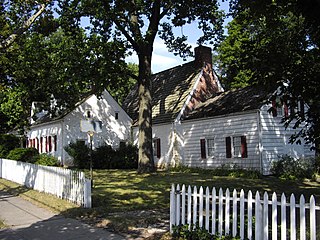
Staten Island is the southernmost borough of New York City, coextensive with Richmond County and situated at the southern most point of New York. The borough is separated from the adjacent state of New Jersey by the Arthur Kill and the Kill Van Kull and from the rest of New York by New York Bay. With a population of 495,747 in the 2020 Census, Staten Island is the least populated New York City borough but the third largest in land area at 58.5 sq mi (152 km2); it is also the least densely populated and most suburban borough in the city.

Richmondtown is a neighborhood in the Mid-Island section of Staten Island, New York City. It is bounded by Arthur Kill Road on the northwest, Richmond Road on the north, Amboy Road on the east and southeast, and the United Hebrew and Ocean View cemeteries on the southwest.

Floyd Bennett Field is an airfield in the Marine Park neighborhood of southeast Brooklyn in New York City, along the shore of Jamaica Bay. The airport originally hosted commercial and general aviation traffic before being used as a naval air station. Floyd Bennett Field is currently part of the Gateway National Recreation Area's Jamaica Bay Unit, and is managed by the National Park Service (NPS). While no longer used as an operational commercial, military, or general aviation airfield, a section is still used as a helicopter base by the New York City Police Department (NYPD), and one runway is reserved for hobbyists flying radio-controlled aircraft.

New Dorp is a neighborhood on the East Shore of Staten Island, New York City, United States. New Dorp is bounded by Mill Road on the southeast, Tysens Lane on the southwest, Amboy and Richmond Roads on the northwest, and Bancroft Avenue on the northeast. It is adjacent to Oakwood to the southwest, Todt Hill to the northwest, Dongan Hills and Grant City, and Midland Beach and Miller Field to the southeast. New Dorp Beach, bordering to the east, is often listed on maps as a separate neighborhood from Mill Road to the shore of Lower New York Bay, but is generally considered to be a part of New Dorp.

Party Monster is a 2003 American biographical crime drama film written and directed by Fenton Bailey and Randy Barbato, who are also producers along with Jon Marcus and Christine Vachon. It stars Macaulay Culkin as the drug-addled "king of the Club Kids". The film tells the story of the rise and fall of the infamous New York City party promoter Michael Alig. This was Macaulay Culkin's first film in nearly nine years since his starring role in the 1994 film Richie Rich.

Michael Alig was an American club promoter and artist who was convicted of felony manslaughter. He was one of the ringleaders of the Club Kids, a group of young New York City clubgoers who became a cultural phenomenon in the late 1980s and early 1990s. In March 1996, Alig and his roommate, Robert D. "Freeze" Riggs, killed fellow Club Kid Andre "Angel" Melendez in a confrontation over a drug debt. In October 1997, Alig pled guilty to first-degree manslaughter. Both men were sentenced to 10 to 20 years in prison. Riggs was released on parole in 2010. Alig was released on May 5, 2014.
The Club Kids were a group of young New York City dance club personalities. The group was notable for its members' flamboyant behavior and outrageous costumes.

Andre Melendez was a member of the Club Kids and purported drug dealer who lived and worked in New York City. He was killed by Michael Alig and Robert "Freeze" Riggs on March 17, 1996. His life and death have inspired several pieces of media, including books, films, music, and television.

The term East Shore is frequently applied to a series of neighborhoods along the Lower New York Bay and the Raritan Bay and within New York City's borough of Staten Island.

Rosebank is a neighborhood in northeastern Staten Island, one of New York City's five boroughs. It borders Clifton to the north, Arrochar to the south, and the Upper New York Bay to the east.
Egbertville is the name of a neighborhood located immediately inland from, but classifiable within, the East Shore of the borough of Staten Island in New York City. Originally named Stony Brook as the island's first county seat, then renamed after a family that owned a farm there in the 18th century, Egbertville was known for a time as Morgan's Corner, from 1838. Soon after this, many Irish families arrived in the area, leading to its being referred to by such names as Tipperary Corners, New Dublin, and Young Ireland.

Bowman Field is a public airport five miles (8.0 km) southeast of downtown Louisville, in Jefferson County, Kentucky. The airport covers 426 acres (172 ha) and has two runways. The FAA calls it a reliever airport for nearby Louisville Muhammad Ali International Airport.

The Aero Club of America was a social club formed in 1905 by Charles Jasper Glidden and Augustus Post, among others, to promote aviation in America. It was the parent organization of numerous state chapters, the first being the Aero Club of New England. It thrived until 1923, when it transformed into the National Aeronautic Association, which still exists today. It issued the first pilot's licenses in the United States, and successful completion of its licensing process was required by the United States Army for its pilots until 1914. It sponsored numerous air shows and contests. Cortlandt Field Bishop was president in 1910. Starting in 1911, new president Robert J. Collier began presenting the Collier Trophy.

Tunnel was a nightclub located at 220 Twelfth Avenue, in the Chelsea neighborhood of Manhattan, New York City. It operated from 1986 to 2001.
Glory Days or Glory Daze may refer to:

The Billiou–Stillwell–Perine House is a Dutch Colonial structure and the oldest standing building on Staten Island, New York.

New Dorp High School, commonly referred to as New Dorp or NDHS, is a public school in New Dorp on the East Shore of the New York City borough of Staten Island in the New Dorp neighborhood. The school is administered by the New York City Department of Education. The school is located at 465 New Dorp Lane next to Miller Field, an army airport turned park, which extends to the Lower New York Bay. New Dorp High School is located in Region 7, which encompasses all of Staten Island and portions of southwest Brooklyn.

The New Dorp Lighthouse is a decommissioned lighthouse located in the New Dorp section of Staten Island, New York City. Funds for the lighthouse were approved by United States Congress on August 31, 1852 and the structure was completed in 1856. The lighthouse, built to serve as a rear range light to mark Swash Channel, was built by Richard Carlow, who also built the similar Chapel Hill and Point Comfort Range Lights in New Jersey around the same time. Ships sailing through Swash Channel were instructed to bring the New Dorp range light “in one” and steer towards the lights until the Chapel Hill Light came into view, which would then mark the channel past West Bank.

Corliss Champion Moseley was a United States Army aviator and later civilian trainer. He won the inaugural Pulitzer Air Race in 1920. Following his service in World War I, where he was credited with one aerial victory, he was placed in charge of all United States Army Air Service schools. As a civilian, he set up flying schools which are estimated to have taught over 25,000 pilots and 5000 mechanics, mostly for service in World War II. He was also a business executive, either helping found or organize Western Air Express.
Screamin' Rachael, born Rachael Cain, is an American musician and Chicago native dubbed the "Queen of House Music" by Billboard magazine,. Rachael has been connected to the evolution of the House music genre. She has worked with performers such as Grandmaster Melle Mel, Marshall Jefferson, Colonel Abrams, Afrika Bambaataa, and many others.























